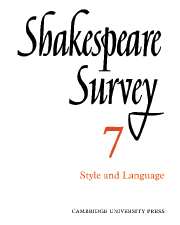Book contents
- Frontmatter
- Fifty Years of the Criticism of Shakespeare’s Style: A Retrospect
- Shakespeare and Elizabethan English
- The Poet and the Player
- Shakespeare’s Orthography in Venus and Adonis and Some Early Quartos
- The New Way with Shakespeare’s Texts: An Introduction for Lay Readers. I. The Foundations
- The Red Bull Company and the Importunate Widow
- Vaulting the Rails
- Shakespeare and the Acting of Edward Alleyn
- The Birmingham Shakespeare Memorial Library
- Shakespeare’s Italy
- International Notes
- Shakespeare Productions in the United Kingdom: 1952
- Acting Shakespeare: Modern Tendencies in Playing and Production
- The Year's Contributions to Shakespearian Study 1 Critical Studies
- 2 Shakespeare’s Life, Times and Stage
- 3 Textual Studies
- Books Received
- Index
- Plate Section
Shakespeare and the Acting of Edward Alleyn
Published online by Cambridge University Press: 28 March 2007
- Frontmatter
- Fifty Years of the Criticism of Shakespeare’s Style: A Retrospect
- Shakespeare and Elizabethan English
- The Poet and the Player
- Shakespeare’s Orthography in Venus and Adonis and Some Early Quartos
- The New Way with Shakespeare’s Texts: An Introduction for Lay Readers. I. The Foundations
- The Red Bull Company and the Importunate Widow
- Vaulting the Rails
- Shakespeare and the Acting of Edward Alleyn
- The Birmingham Shakespeare Memorial Library
- Shakespeare’s Italy
- International Notes
- Shakespeare Productions in the United Kingdom: 1952
- Acting Shakespeare: Modern Tendencies in Playing and Production
- The Year's Contributions to Shakespearian Study 1 Critical Studies
- 2 Shakespeare’s Life, Times and Stage
- 3 Textual Studies
- Books Received
- Index
- Plate Section
Summary
In 1763, the Theatrical Review (No. 2) published a letter forged by George Steevens but supposed to have been written by George Peele to Christopher Marlowe. Showing a carefree disregard for chronological possibilities, the letter informed Marlowe that Shakespeare had based the speech about the “excellencie of acting” in Hamlet upon “opiniones gyven by Alleyn touchyng that subjecte”. Sir Sidney Lee has amply demonstrated the wide currency attained by this amiable fiction during the following hundred years. Its wide acceptance during the nineteenth century is of some interest because its exaltation of Alleyn into an authority on acting fit to instruct Shakespeare offers so diametrical a contrast to modern theories of the relationship between these two men. Alleyn’s reputation as an actor has certainly declined during the present century. “Somewhat over-heavy” and “an exaggerated style of acting” are recent and typical pronouncements on his histrionic art. Two reasons explain the rather patronizing tone of many modern assessments of Alleyn’s quality. First, it is assumed that when Burbage took the role of Hamlet and delivered his advice to the players at the Globe in 1602, he was indirectly criticizing the technique of Alleyn, the leading actor of the rival company at the Fortune playhouse. Thus Hamlet’s remarks about good and bad acting, far from having been originally expounded by Alleyn, are now widely believed to have been directed against him. Secondly, the discovery in 2 Henry Ⅳ of parodies of passages in plays acted by Alleyn’s men at the Rose has encouraged at least one critic to assume that Shakespeare was gibing at Alleyn’s style of acting even before he wrote Hamlet.
- Type
- Chapter
- Information
- Shakespeare Survey , pp. 82 - 89Publisher: Cambridge University PressPrint publication year: 1954



